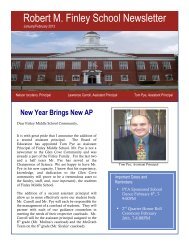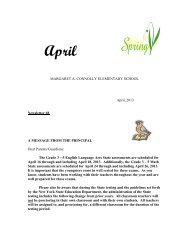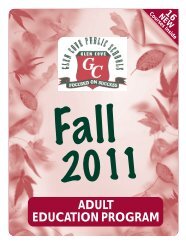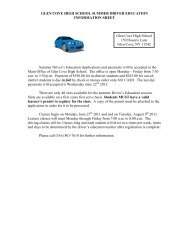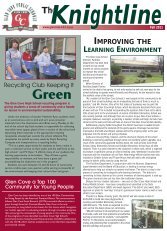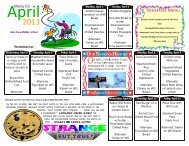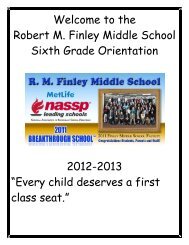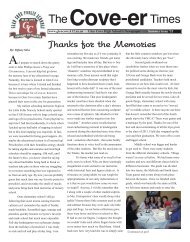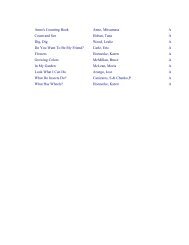ROBERT M. FINLEY MIDDLE SCHOOL - Glen Cove City Schools
ROBERT M. FINLEY MIDDLE SCHOOL - Glen Cove City Schools
ROBERT M. FINLEY MIDDLE SCHOOL - Glen Cove City Schools
You also want an ePaper? Increase the reach of your titles
YUMPU automatically turns print PDFs into web optimized ePapers that Google loves.
<strong>ROBERT</strong> M. <strong>FINLEY</strong> <strong>MIDDLE</strong> <strong>SCHOOL</strong>:“Where every student gets a first class seat.”Master NotebookStudy Skills ProgramParent/Teacher Information Packet
HELPING YOUR CHILD WITH ORGANIZATIONAND STUDY SKILLSBy: Joan SeditaAdapted for the Robert M. Finley Middle School by Anael AlstonINTRODUCTIONStudents need the right tools (such as notebooks and assignment books) and basic studyskills (such as note taking and summarizing) to be successful in school. Some studentsare able to “intuit” and develop these strategies on their own. They can create systemsfor organizing, processing, and comprehending what they read or hear in class; planninghomework and long-term assignments; studying for tests; and determining effective testtaking strategies. Many students, however, need direct, systematic instruction to developthese skills. Weaknesses in reading, writing, and organizational skills, or lack ofattention may affect some students’ ability to self-design and independently apply studystrategies. These students can learn study skills, but they need specific instruction andsufficient practice to do so.ORGANIZATION STRATEGIESThe Master Notebook SystemThe Master Notebook System is an ongoing system for filing, organizing, and studyingschool papers and materials. The Master Notebook System consists of two parts:• Working notebook• Reserve filesParents and teachers can help students set up a Working Notebook and transfer materialfrom the Working Notebook to the Reserve Files on a regular basis.Working NotebookThe Working Notebook is the main tool your child will use for all of his classes andhomework. It holds all the papers and information needed each day. Any three-ringbinder can serve as a Working Notebook. However, it is recommended that you use anylon, zippered binder because it tends to hold up better and lasts longer. The ring sizeshould be 1.5 to 2 inches in diameter. Your child’s Working Notebook should contain:• A portable, three-hole punch• A zippered pouch with three holes to hold highlighters, pencils, pens, clips,“sticky notes” and other small supplies• A monthly calendar (provided)• Section dividers for each subject• An assignment book (provided)2
• Several plastic page protectors to keep reference papers. (such as a copy of theclass schedule, math facts, spelling list, etc.)These items are available at the Middle School for your convenience or at most officesupply stores, in a three-hole punched format, so they can be inserted easily into thenotebook. This is important, because if the items are not attached to the notebook, theywill get lost in backpacks or left at home or school.On a daily basis, your child should date, three-hole punch, and file all of his/her schoolpapers under the appropriate divider for each subject. Your child should also noteassignments in detail in the assignment book. The monthly calendar is used to noteupcoming tests, quizzes or long-term projects.Reserve FilesReserve Files are used for storing completed work and material no longer needed forclass. The files usually stay at school, but if a parent insists on using the system at home,they may be kept there. They may be stored in a filing cabinet, a plastic or cardboard filebox, or a portable file box. There should be one section of the files for each subject.Reserve Files provide a single place to organize and store finished work. They also keepthe working notebook from getting too full. On a regular basis, preferably at the end ofeach week, your child should remove all notes, homework, and other papers not neededfor class the next week and clip them together by subject. Your child should then reviewthe material, make a list of the main points covered in class that week, and write asummary in his own words for each subject. The next step is to attach the list andsummary to the clipped-together work and to store the packet in the Reserve Files. Afterseveral weeks, your child’s Reserve Files will contain a series of packets, filed bysubject, which can be used to review and study for a unit or semester test.The goal with this system is to eventually have your child apply these strategiesindependently, but many children will need significant help and practice with an adultbefore they can do this on their own.Reference Pages for the Working NotebookPlastic sheet protectors can be used to create a reference section in the WorkingNotebook for keeping information that your child needs to reference on a frequent basis.Some examples of items for reference pages include:• A personal spelling list of commonly used words that are particularly difficult foryour child• A list of transition words and phrases that will improve the quality of your child’swriting assignments (e.g., words such as however, for example, finally, therefore,in conclusion, another, first, second, etc.) (PROVIDED)• Math facts• Charts or graphs given in class (such as a time line of events for social studies ora periodic table for science)• How-to lists (such as how to answer an essay question, how to organize yournotebook) and templates (such as formats for science experiments)3
• A copy of the class scheduleGeneral reference pages, such as a class schedule, can be kept at the beginning or end ofthe Working Notebook. Reference pages that are subject specific can be kept in a subjectsection.The combination of the Working Notebook and Reserve Files makes it easier for yourchild to find exactly the papers they need and to avoid losing important papers. Thesystem also eliminates the overstuffed notebooks and backpacks that typically develop asthe school year progresses.Organizing Homework, Study Space and TimeOrganize HomeworkA good assignment book is essential for completing homework successfully. The MiddleSchool has designed and will provide a new assignment book for the year. There are twopages per school day, and it includes space for writing homework assignments in allsubjects, a space for making a note for upcoming tests and long-term assignments withdue dates, and room for parent/teacher notes or lists of things to bring home or to school.Study SpaceRoutines about when and where homework is completed are essential. Although moststudents will not admit it, they know they benefit from structure for completinghomework. The structure can be imposed by you or by teachers.Your child should have an identified study space in the home. Preferably, the spaceshould be used solely for school work. It can be in your child’s room, a quiet area of theliving room, or even a walk-in closet. The space should be free of visual and auditorydistractions (including games, TV, radio, and other children). It should have a clear worksurface, good light, and a comfortable yet supportive chair. All necessary supplies shouldbe on hand before the child starts, including a dictionary, pencils, paper, ruler, andcalculator.On the first day of school, you should establish a routine with your child for completinghomework. The routine needs to reflect your child’s individual learning style. Forexample, some students with attention weaknesses work best if they spend no more thanfifteen minutes on a subject, move to another assignment for fifteen minutes, and thenreturn to the original assignment (rather than work continuously on the same assignment).Some students do better if they spend a half-hour after school on homework, and thentake a break to play or eat dinner, then complete the homework.While the best time for completing homework differs for each student, it’s important toestablish what it is and make it a routine.Organizing TimeStarting in the third or fourth grade, your child should be taught and encouraged to usedaily schedule books and calendars. By posting a large “family” calendar in a common4
area, all members of your family can enter and check events, such as sports practices,family outings, and school dates. This is a good model to learn from.Also, encourage your child to use the monthly calendar in his working notebook.Monthly calendars are important for reminding you and your child of upcoming tests,long-term project due dates, and special activities. Items and events such as these shouldbe noted on the monthly calendar during the school day, and checked by the parent eachday. Pencil should be used because dates may change.A daily planner can be used to sketch out how homework, play time, club meetings, andthe like can be worked into each day. This helps avoid the conflict that often occursabout when to do homework, since you will reach a decision together based on theavailable hours in a day. It also shows your child that his free time is valued and will beincluded in his schedule.It is important not to make assumptions about how well your child can tell time without adigital clock, understand and follow class schedule, or sense how time flows daily,weekly, and monthly. Some students have difficulty with the simplest aspects of timeand planning, and these weaknesses may not be readily apparent.Communicating with TeachersToo often, teachers claim that parents are not involved enough with their children’sschool work and parents claim that teachers do not provide enough information for themto help their children. To avoid this situation, communicate with your child’s teachers assoon as possible and maintain that communication throughout the year.Ask teachers what organization structures they provide, what they expect from students,and how you can help your child organize materials and study effectively. Ask theteacher to write homework assignments, with a lot of detail, on a blackboard for yourchild to copy so you will know what the homework is and how it is to be completed. Bewilling to check, sign, and return a daily homework sheet to maintain communicationbetween you and the teacher. If you think your child is spending too much or too littletime on homework, asks the teacher to suggest how long each assignment should take tocomplete, then note back to the teacher how long it actually took. This will help you andthe teacher have a better understanding of your child’s homework needs.As an additional source of communication, all teachers have an e-mail address and mostteachers have personal or team e-boards. The e-boards will outline course content,student expectations, as well as upcoming assignments. We appreciate your active role inyour child’s success.5
Organizing Study SpaceWhere students study and do homework is almost as important as how they study,especially for students who are easily distracted. A good study space should includethese elements:• A good light• A comfortable yet supporting chair• A clear work space, free of visual distractions (such as posters or toys), andauditory distractions (such as TV, radio, conversations, or the sound of otherchildren playing).• A consistent place where the student always studies and, if possible, uses onlyfor studying• All necessary tools and supplies, such as a pencil sharpener, ruler, paper,calculator, and dictionaryDepending on how long they are working, students should plan to take appropriate breaksto avoid becoming fatigued. They should complete one assignment at a time; all otherwork should be removed from the work surface so they do not become distracted or feeloverwhelmed by the other assignments they have yet to complete.In addition, students should identify one place in the home where they can assembleeverything they will need for the next day of school This “arrival and departing station”can be a corner on the floor near the front door, a book shelf in their room, or perhaps ashelf near the kitchen door. When they are finished with homework, it is a good time toassemble their work, books, and any special items they might need for the next day (e.g.gym clothes, show-and-tell item) and place them in this spot. Everything should be readyso the students walk out the door on time.6
NOTEBOOK/ORGANIZATIONAL SKILLSSTUDY SKILLS GOALS BY GRADE(Minimum achievement by end of year)6 th grade 7 th grade 8 th gradeAssemble a working notebook, introduce, with help independently independentlyuse a checklist to assess the notebookMaintain a working notebook introduce, with help independently independentlythroughout the school yearCull through the working notebook on a introduce, with help with help independentlyregular basis, assemble study packets, keep in classroom keep in classroom Fall: keep in classand save in reserve file. Spring: keep homeCreate a cover sheet(s) for packets introduce with help independentlygiven by teacherall yearOrganize and use reserve packets introduce with help independentlyfor tests and midtermsNote homework in a daily assignment book introduce, with help independently independentlyNote tests/long-term assignments introduce, with help independently independentlyon monthly calendar
Reference Sheets and Examples
Notebook Owner: ________________________Date:____________________Finley Middle School Notebook Checklist(10 points each)YESNO1. 3 Ring Binder ____ ____2. Highlighters ____ ____3. Transition list ____ ____4. Pens and sharpened pencils w/ erasers ____ ____5. Agenda book properly maintained ____ ____(being used to copy homework and plan)6. Loose leaf paper ____ ____7, Monthly calendar ____ ____8. Academic Sections ____ ____9. Zippered pouch for pens/ pencils ____ ____10. Neatness/Organization ____ ____TOTAL SCORE: _____*YOUR CHILD HAS BEEN RECOMMENDED FOR NOTEBOOK ASSISTANCE ______Notebook checked by: ______________________________________________Parent/Guardian Signature: _____________________________ Date: _______9
Master Notebook Help Referral Form• All students are expected to come prepared with notebook in hand.Name: _____________________________Teacher: ____________________________Grade: _____________Date: ______________Specific comments:A Master Notebook appointment date has been scheduled for your child with theirGuidance Counselor/ Homework Club(circle one):Name: __________________________________Date: ___________________________________Place:Counselors Office/Library – (circle one)_____________________________Signature of Parent/ Guardian10
(main ideas)(details)www.keystoliteracy.com
AbbreviationsWhen you take notes, you will save time and energy by using abbreviations.The following list shows some common abbreviations.If you are in a class that uses a specific word over and over, such as CivilWar in American History, it may be helpful to make up your ownabbreviations.For example, you could use CW.The most important thing is that if you make up abbreviations, you shouldbe sure to remember what they mean.Common abbreviations:Equal: =With: w/Without: w/oNumber: #At: @And: +And so forth: etc.Department: dept.Compare: cfFor example: e.g.Against: vs.Introduction: intro.Organization: org.Politics: pol12
Daily Home Time Planning: After SchoolDate: ____________________________________3:00 _________________________ 6:15 _________________________3:15 _________________________ 6:30 _________________________3:30 _________________________ 6:45 ________________________3:45 _________________________ 7:00 _________________________4:00 _________________________ 7:15 _________________________4:15 _________________________ 7:30 _________________________4:30 _________________________ 7:45 _________________________4:45 _________________________ 8:00 _________________________5:00 _________________________ 8:15 _________________________5:15 _________________________ 8:30 _________________________5:30 _________________________ 8:45 _________________________5:45 _________________________ 9:00 __________________________6:00 _________________________ 9:15 _________________________Notes:© 1999 Sedita Learning Strategieswww.keystoliteracy.com
Common Greek and Latin RootsRoot Meaning Origin ExamplesAud Hear Latin Audiophile, auditorium, auditionAstro Star Greek Astrology, astronaut, asteroidBio Life Greek Biography, biologyDict Speak, tell Latin Dictate, predict, dictatorGeo Earth Greek Geology, geographyMeter Measure Greek Thermometer, barometerMin Small, little Latin Minimum, minimalMit, mis send Latin Mission, transmit, remit, missilePed Foot Latin Pedestrian, pedal, pedestalPhon Sound Greek Phonograph, microphone, phonemePort Carry Latin Transport, portable, importScrib, Write Latin Scribble, manuscript, inscriptionscriptSpect See Latin Inspect, spectator, respectStruct Build, form Latin Construction, destruction, instructMost Common Prefixes and Suffixesprefix % of all words suffix % of all words• un- 26%• re- 14%• in-,im-,il-,ir- (not) 11%• dis- 7%• en-, em- 4%• non- 4%• in-, im- (in) 3%• over- 3%• mis- 3%• sub- 3%• pre- 3%• inter- 3%• fore- 3%• de- 2%• trans- 2%• super- 1%• semi- 1%• anti- 1%• anti- 1%• mid- 1%• under- (too little) 1%• ALL OTHERS 3%• -s, -es 31%• -ed 20%• -ing 14%• -ly 7%• -er, -or (agent) 4%• -ion,-tion, -ation, -ition 4%• -able, -ible 2%• -al, -ial 1%• -y 1%• -ness 1%• -ity, -ty 1%• -ment 1%• -ic 1%• -ous, -eous, -ious 1%• -en 1%• -er 1%• -ive, -ative, -tive 1%• -ful 1%• -less 1%• -est 1%• ALL OTHERS 7%©www.keystoliteracy.com



